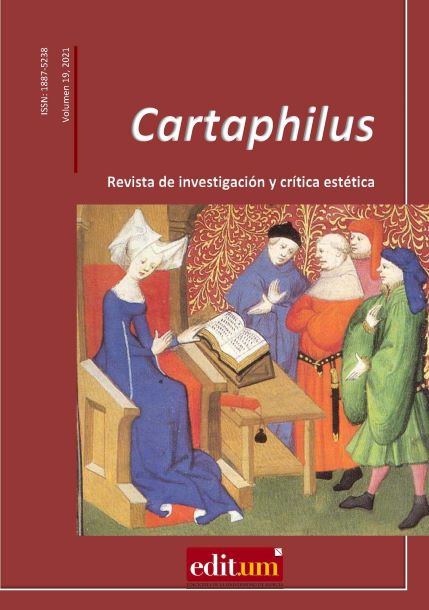“Quel nobilissimo sesso di Donne”. Describing a semiotic construction of a Gender’s Grammar in a text from the Italian “Querelle des Femmes”: Cesare Barbabianca’s L’assonto amoroso in difesa delle donne (1593)
Abstract
Bodies can be defined as devices, in which, all sort of meanings can be written and re-written. In this way, on the social sphere, subjects use their bodies to perform behaviours and represent identities, which can be analysed, both them, as a semiotic form sustained by structures reducible to Grammars. In consequence, Gender, is a a symbolic and embodied technology, which has been imposed to subjetcs, as if they were poetic or dramatic artifacts.
In this essay, we aim to analyse the semiotic structure of some historical concepts such as “beauty” or “virtue” –because they contain prescriptions of Gender– on Male and Female bodies represented in a text from the Italian “Querelle des femmes” included at the Veneto Dispute: Cesare Barbabianca’s L’assonto amoroso in difesa delle donne (1593). This text, through the enounciated performances of bodies and the scheme of actants, shows a convergence of voices and arguments that, based on the discussion eith the tradition, allows us to deconstruct models, describe the prescriptive grammar of Gender, and, at least, question the semantic articulation of some historical concepts.
Downloads
-
Abstract240
-
PDF (Español (España))512
References
Aquino, Tomás de (1993): Summa Theologica. Tomo II. Madrid: Biblioteca de autores cristianos.
Barbabianca, Cesare (1593): L’assonto amoroso in difesa delle donne. Treviso: Aurelio Reghettini.
Bartolotta, Salvatore y Tormo-Ortiz, Mercedes (eds.) (2019): Escritoras italianas inéditas en la Querellea de las Mujeres. Ed. en dos volúmenes. Madrid: Editorial UNED.
Broullón-Lozano, Manuel A. (2020): “Dos aproximaciones a L'Assonto amoroso in difesa delle donne, de Cesare Barbabianca (1593): textualidad y método”. Revista de la Sociedad Española de Italianistas, 14, 101-112.
Cox, Virginia (2008): Women’s Writing in Italy 1400-1650. Baltimore: The John Hopkins University Press.
Dialeti, Androniki (2029): “Gendering Civic Humanism: Political Subjecthood and Male Hegemony in Renaissance Italy”. En Tsakiropoulou-Summers, T. y Kitsi-Mitakou, H. (eds.), Women and the Ideology of Political Exclusion: From Classical Antiquity to the Mod¬ern Era (pp. 205-220). New York: Routledge.
Dialeti, Androniki (2020): ““Io posso formar questa donna a modo mio”: Male self-fashioning and the imageries of Pygmalion and Zeuxis”. Revista de la Sociedad Española de Italianistas, 14, 17-26.
Favaro, Maiko (2012): Tra musica, scienza e riflessione sull’amore: l’Accademia Palladia di Capodistria. Recuperado de https://backdoorbroadcasting.net/2012/09/maiko-favaro-tra-musica-scienza-e-riflessione-sullamore-laccademia-palladia-di-capodistria/
Foucault, Michel (1977). Historia de la sexualidad. Ed. en cuatro volúmenes. Madrid: Siglo XXI.
Genette, G. (1989). Palimpsestos: la literatura en segundo grado. Madrid: Taurus.
Genette, G. (2002). Umbrales. Madrid: Siglo XXI.
Greimas, Algirdas Julien y Courtés, Joseph (1982): Diccionario razonado de la teoría del lenguaje. Ed. en dos volúmenes. Madrid: Gredos.
Hauser, Arnold (1969): Historia social de la literatura y el arte. Ed. en tres volúmenes. Madrid: Guadarrama.
Malcolm, Noel (2015): Agents of Empire. Knoghts, Corsairs, Jesuits and Spies in the Sixteenth-Century Mediterranean World. Oxford, Nueva York: Oxford Unioversity Press.
Ovidio (1983): Metamorfosis (trad. Ana Pérez Vega). Barcelona: Bruguera.
Copyright (c) 2022 Manuel A. Broullón-Lozano

This work is licensed under a Creative Commons Attribution-NonCommercial-NoDerivatives 4.0 International License.
Works published in this journal are subject to the following terms:
1. The Servicio de Publicaciones of the University of Murcia (the publisher) reserves the copyright of the published works and encourages and allows their reuse under the usage licence indicated in point
© Servicio de Publicaciones, Universidad de Murcia, 2015
2. Works are published in the electronic edition of the journal under a Creative Commons Reconocimiento-NoComercial-SinObraDerivada 4.0 International licence (legal text). They may be copied, used, disseminated, transmitted and publicly displayed, on condition that: i) the author and original source of the publication are cited (journal, publisher and URL of the work); ii) the material is not used for commercial purposes; iii) the existence and specifications of this licence for use are mentioned.

3. Self-archiving conditions We allow and encourage authors to electronically disseminate the preprint versions (the pre-review version) and/or post print (the version that has been reviewed and accepted for publication) of their works before they are published as this encourages earlier circulation and dissemination and so a potential increase in their citation and impact in the academic community.




